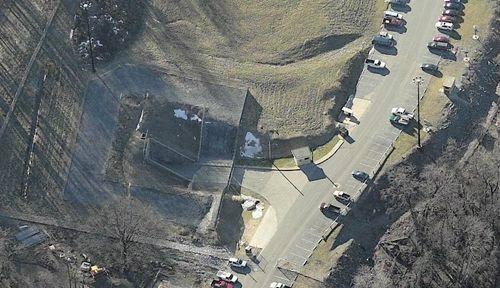It remains unclear whether President Biden revealed information that may have been part of a classified White House briefing when he spoke of nuclear Armageddon at a fundraising event in New York several days ago. However, to even mention the words should spin up lots of meetings at the Pentagon and the National Security Council, much less discussions with other world leaders. Even more meaningful would be to be having rehearsals and conversations with all associated American military across the world to ensure readiness and procedures. Instead, we have a White House and president that is traveling talking about mid-term elections, abortion law, climate change and eating ice cream.
But read on….
 Raven Rock
Raven Rock
The following essay is an adapted excerpt from William Doyle’s new book, Titan of the Senate: Orrin Hatch and the Once and Future Golden Age of Bipartisanship, published by Center Street Books.
Newsweek: Suddenly, in the wake of Russian threats to use tactical nuclear weapons, the world faces the possibility of a nuclear war that President Biden has alarmingly but accurately said threatens Armageddon. Tensions have not been this high since the 1962 Cuban Missile Crisis.
It is worth remembering that when we talk about nuclear war, we are talking about the violent deaths of millions—perhaps billions—of people, and possibly the end of most life on the planet. President Dwight Eisenhower once said that if a nuclear war happens, “there just aren’t enough bulldozers to scrape the bodies off the street.”
Experts have long feared that a single nuclear detonation, even a small one, would instantly trigger an irreversible chain reaction leading to the widespread firing of nuclear weapons. As Soviet leader Leonid Brezhnev put it in 1978, “The first time one of those things is fired in anger, everything is lost. The warring nations would never be able to put things back together.”
The precise choreography of launching nuclear weapons is veiled in secrecy, but speculative glimpses can be obtained through open-source accounts and interviews with nuclear experts. If an American president learns of an imminent nuclear attack, he or she would turn to the nearby military officer who carries a bulging briefcase nicknamed the “nuclear football,” the most powerful instrument of mass murder that humankind has ever created. It contains the codes and communications equipment that would enable the president to authorize the launch of nuclear weapons from submarines, land-based missile silos, cruise missiles, aircraft and other platforms.
In a nuclear crisis, the president can be flown by helicopter to the “backup Pentagon,” known as Raven Rock, or Site R, a small-city-size complex carved deep inside a mountain near Blue Ridge Summit on the Pennsylvania-Maryland state line and about seven miles north of the presidential retreat at Camp David.
Raven Rock is believed to serve as a fully equipped alternative to the Pentagon “war room,” or National Military Command Center, and it is believed to have been used by Vice President Dick Cheney and other officials after the attacks on Sept. 11, 2001. Author James Bamford described Raven Rock as “a secret world of five buildings, each three-stories tall, computer-filled caverns, and a subterranean water reservoir,” all underground and accessible by a helipad and a giant tunnel. According to author Garrett Graff, the site has “power stations, underground water reservoirs, a small chapel, clusters of three-story buildings set within vast caverns, and enough beds to accommodate two thousand high-ranking officials from the Pentagon, the State Department, and the National Security Council.” Graff added, “You can add to that list police and fire departments, a cafeteria, and everything else you would find in a normal small city.”
Through the football and other available communications tools, the president would be linked by voice and video to the Department of Defense’s National Military Command Center at the Pentagon, known as the “war room,” and to Strategic Command headquarters, or STRATCOM, at Offutt Air Force Base south of Omaha, Nebraska, which commands the nation’s arsenal of strategic nuclear weapons. If the secretary of defense, national security adviser, and chairman of the Joint Chiefs of Staff could be reached, they and other high military officials would be patched into the call, but the decision to launch nuclear weapons would be the president’s alone, presumably in consultation with one or more of top military leaders. According to the late Bruce Blair, a former Minuteman missile launch control officer and nuclear weapons historian at Princeton University, if missiles were confirmed to be on their way toward the United States, the president could have “as little as six minutes” to decide on a course of action, including ordering the launch of hundreds of long-range strategic nuclear warheads that are immediately available to fire.
If the president decides to order a nuclear launch, he and his military aide would quickly review the options listed in a briefing book inside the football. The American version of the football is not believed to contain a “red button” or to consist primarily of elaborate computer-style gear—unlike Russian president Vladimir Putin‘s nuclear football, the Cheget, which is believed to consist mainly of a high-tech laptop device—but communications equipment and simplified charts illustrating the various options and targets to select from the latest U.S. nuclear war plan.
The military aide would reach into the football and produce a small object resembling a credit card, nicknamed the “Biscuit,” upon which is written the “Gold Code,” a sequence of alphanumeric symbols that the president would read aloud to authenticate his identity as commander-in-chief. This would be the final step to launch nuclear weapons, making the Biscuit the most dangerous object on the planet. But at least two American presidents have apparently managed to lose track of theirs. In the 1970s and 1980s, when the Gold Codes were kept on a Biscuit card that the chief executive usually carried on his own person rather than inside the football, Jimmy Carter is believed to have misplaced his Biscuit when his suit was sent to the dry cleaners. In 1981, Ronald Reagan’s copy was sealed away for five days by the FBI after George Washington University Hospital emergency room staff cut off Reagan’s thousand-dollar business suit and put the card in a medical bag in the wake of his attempted assassination.
President Bill Clinton kept his Biscuit and his credit cards wrapped up with a rubber band, but, incredibly, he managed to lose it for a substantial length of time, according to a top military official. “The codes were actually missing for months,” wrote General Hugh Shelton, Clinton’s chairman of the Joint Chiefs of Staff from 1997 to 2001. “That’s a big deal—a gargantuan deal.”
Within three or four minutes of the president’s order, missiles would shoot out of their silos in the American Midwest, then about 10 minutes later the submarines would start firing missiles out of their tubes one at a time every 15 seconds. The ICBMs would fly high above the earth’s atmosphere and travel at speeds of 14,000 mph, descending on targets in, for example, Russia, China, or North Korea, in about 25 minutes. The submarine-launched missiles, fired from waters closer to their aim points, could have flight times of as little as 12 minutes. None of the missiles could be recalled. Given the poor performance of the Russian military in Ukraine, there is every reason to expect that Russian President Vladimir Putin’s missiles could misfire, malfunction, fly off course and strike unintended targets.
Not that it would matter much. If even a portion of the alert U.S. and Russian strategic missile forces is fired, large parts of the earth would plunge quickly into hell. Untold millions of people would be smashed, blasted, crushed, vaporized, and burned to death. The initial blasts would create radiation-filled shock waves of outward pressure that would topple skyscrapers, shred people with flying glass and debris, and hurl them across cities. Electromagnetic pulses from air bursts would decapitate the nervous systems of the world’s economy by blowing out fiber-optic lines, power grids, cell phones and electrical circuits, banking systems, and air traffic control networks.
The fireballs would transform into mushroom clouds of condensed water and debris that would rise high into the stratosphere, expand to 50-mile diameters, and shower the earth with radioactive fallout for decades to come. By the end of the first day, hospitals would be overwhelmed, mass fires would rage, and cities and suburbs would be consumed with riots, chaos, and attempted mass migrations. Nations would be in full-scale collapse, and hundreds of millions of people would be dead inside of a week.
This is what we are talking about when we talk about nuclear war.
And this is why total nuclear disarmament must be the most urgent priority of every government on Earth.
William Doyle is a New York Times bestselling, award-winning author and TV producer. His books include An American Insurrection: James Meredith and the Battle of Oxford, Mississippi, 1962 (Doubleday, 2002); Navy SEALs: Their Untold Story (co-authored with former U.S. Navy SEAL Dick Couch, HarperCollins, 2014); PT 109: An American Epic of War, Survival and the Destiny of John F. Kennedy (HarperCollins, 2015) Let the Children Play (co-authored with Pasi Sahlberg, Oxford University Press, 2019) and many others.






